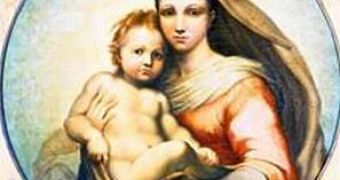Many old paintings can be tricky in determining their real author.
But new technologies ease the research of the scientists.
New analyses have solved a 20-year enigma around the date of a Madonna and Child painting, the "de Brecy Tondo," with a still unidentified author.
However, a vivid debate occurs as to who painted the "de Brecy Tondo," which is too similar to the "Sistine Madonna," the famous opera of the well known Italian Renaissance artist Raphael.
Howell Edwards, working in Raman spectroscopy at the University of Bradford in the United Kingdom, employed the laser-based technology to discover the yellow pigments and glue typical of the Renaissance period, which places the painting between the 14th and 16th centuries, at the same time with the "Sistine Madonna".
"Prior to Professor Edwards' work, there has been no consensus amongst art historians as to the age of the painting," said Timothy Benoy, secretary and trustee of the de Brecy Trust, and coauthor of a report on the new finding.
The researchers discovered the presence of massicot, a lead-based yellow colorant highly employed by painters before the introduction of a new one named Naples Yellow in the 1700s. Massicot, also discovered in Vermeer's 1670 painting "Young Lady Seated at the Virginals," has been employed to find the date of previous paintings.
Beside massicot, the laser also revealed the presence of organic remains pointing to a vegetable (starch-based) glue, which signals the Renaissance period.
During the last 24 years, the painting was analyzed in other 8 laboratories worldwide in an intent of determining its date and author. In 2003, a Belgian team found the painting was the first in which an artist utilized a medieval blue colorant named turnsole. "Analytical information from several techniques and laboratories support the assignment of this painting to the Renaissance," said Edwards.
Many art historians believe, based on the similarities between the "Sistine Madonna" and the "Tondo", that Raphael is the author. Even if this research cannot confirm this, at least it places it sometime in Raphael's period.

 14 DAY TRIAL //
14 DAY TRIAL //